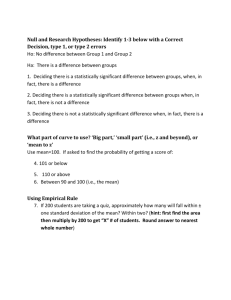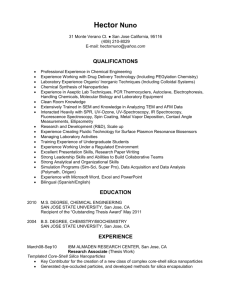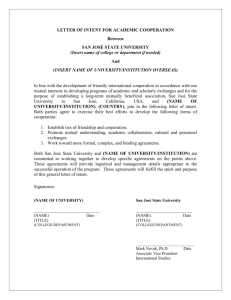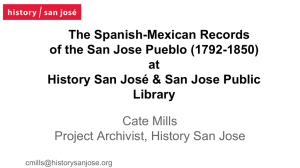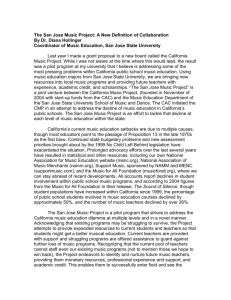Book Title: Politics, History, and Economy in the Classic Maya Polity
advertisement
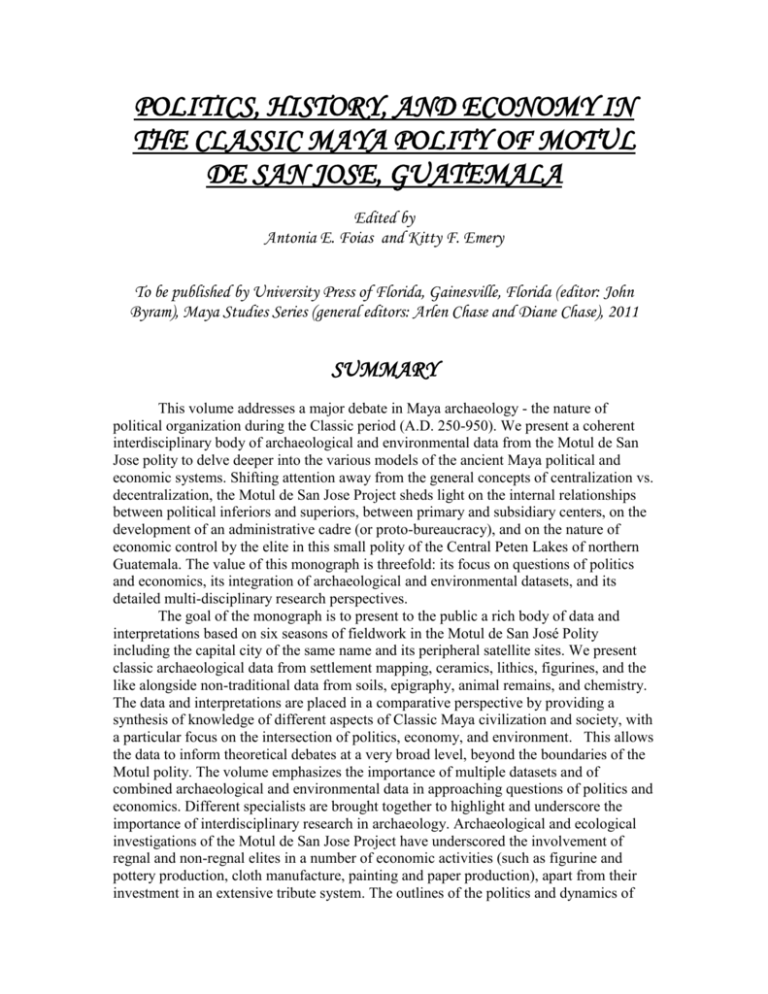
POLITICS, HISTORY, AND ECONOMY IN THE CLASSIC MAYA POLITY OF MOTUL DE SAN JOSE, GUATEMALA Edited by Antonia E. Foias and Kitty F. Emery To be published by University Press of Florida, Gainesville, Florida (editor: John Byram), Maya Studies Series (general editors: Arlen Chase and Diane Chase), 2011 SUMMARY This volume addresses a major debate in Maya archaeology - the nature of political organization during the Classic period (A.D. 250-950). We present a coherent interdisciplinary body of archaeological and environmental data from the Motul de San Jose polity to delve deeper into the various models of the ancient Maya political and economic systems. Shifting attention away from the general concepts of centralization vs. decentralization, the Motul de San Jose Project sheds light on the internal relationships between political inferiors and superiors, between primary and subsidiary centers, on the development of an administrative cadre (or proto-bureaucracy), and on the nature of economic control by the elite in this small polity of the Central Peten Lakes of northern Guatemala. The value of this monograph is threefold: its focus on questions of politics and economics, its integration of archaeological and environmental datasets, and its detailed multi-disciplinary research perspectives. The goal of the monograph is to present to the public a rich body of data and interpretations based on six seasons of fieldwork in the Motul de San José Polity including the capital city of the same name and its peripheral satellite sites. We present classic archaeological data from settlement mapping, ceramics, lithics, figurines, and the like alongside non-traditional data from soils, epigraphy, animal remains, and chemistry. The data and interpretations are placed in a comparative perspective by providing a synthesis of knowledge of different aspects of Classic Maya civilization and society, with a particular focus on the intersection of politics, economy, and environment. This allows the data to inform theoretical debates at a very broad level, beyond the boundaries of the Motul polity. The volume emphasizes the importance of multiple datasets and of combined archaeological and environmental data in approaching questions of politics and economics. Different specialists are brought together to highlight and underscore the importance of interdisciplinary research in archaeology. Archaeological and ecological investigations of the Motul de San Jose Project have underscored the involvement of regnal and non-regnal elites in a number of economic activities (such as figurine and pottery production, cloth manufacture, painting and paper production), apart from their investment in an extensive tribute system. The outlines of the politics and dynamics of the Motul de San Jose polity point to a more centralized political system than previously envisioned. The different chapters in this book are also meant to build the foundation for the next stage of debates on social, political and historical issues in Maya archaeology. We end the volume with a new perspective on the critical questions and the importance of solid archaeological data as a foundation to such discussions. We emphasize the data in this volume, but also the interpretations reached, and how these interpretations and findings contribute to on-going discussions in this professional field. What makes our project fascinating is that Motul de San Jose is located in the Central Peten area, close to Tikal, and clearly involved in the politics of this super-state and its arch-enemy Calakmul. We have used new ecological analyses, such as soil stable carbon isotope analyses to consider the nature of agricultural production and its correlation with human settlement. The epigraphic and artistic evidence from a significant but less used corpus (the Ik Style polychromes) illuminates details of political organization not available in other parts of the Maya lowlands where only the royal elites are recorded on large, public stone monuments. PRELIMINARY TABLE OF CONTENTS PART I: INTRODUCTION Chapter 1: Politics and Economics: Theoretical Perspectives of the Motul de San Jose Project By Antonia E. Foias and Kitty F. Emery Abstract: This chapter introduces the theoretical debates within which the archaeological and ecological research of the Motul de San Jose Project was conducted between 1998 and 2003. The project engages the major debates on the dynamics of political structure within the Maya civilization during the Classic period, and locates the research at the intersection between economics and politics. It emphasizes the importance of interdisciplinary research, combining archaeological and ecological data. Shifting attention away from the general concepts of centralization vs. decentralization, the Motul de San Jose Project dwells on the internal relationships between political inferiors and superiors, between primary and subsidiary centers, on the development of an administrative cadre (or proto-bureaucracy), and on the nature of economic control by the elite in this small polity of the Central Petn Lakes of northern Guatemala. PART II: ARCHAEOLOGICAL INVESTIGATIONS AT MOTUL DE SAN JOSE Chapter 2: History and Politics: The Polychrome Pottery of Yajaw Te’ K’inich, Divine Lord of the Ik’ Polity By Dorie Reents-Budet and Ronald L. Bishop Abstract: The 8th-century A.D. ruler Yajaw Te’ K’inich employed a number of mechanisms to augment his social, political and economic power as part of his efforts to expand the boundaries and influence of the Ik’ polity, centered at Motul de San Jose. One of these may have been the sponsorship of elaborate feasting events held in honor of his accession, war victories and other ritual affairs. Feasting events are implied by the contents of middens surrounding the elite residential compounds in the city’s central precinct and by a large corpus of special drinking vessels painted with representations of Yajaw Te’ K’inich. Yet the dramatic difference in quality of the painted images indicates that many different painters created these wares, although the number of workshops and their locations remain unknown. However, these can be inferred by combining the data sets from paste chemical compositional analysis, art historical research and hieroglyphic decipherment. This paper presents the results of our multi-disciplinary analysis of the specialized 8th-century Ik’ ceramics that includes pottery excavated at the site and unprovenienced whole vessels. When combined with archaeological field data, we can achieve a better understanding of the sociopolitical history of the Ik’ polity during the reign of Yajaw Te’ K’inich. Chapter 3: Excavations in the Epicenter of Motul de San Jose: Architecture, Volumetrics and Social Stratification By Antonia E. Foias, Christina T. Halperin, Elly Spensley Abstract: This chapter explores the stratification in the epicenter of Motul de San Jose from social, economic, and political perspectives from the excavations undertaken as part of the test pitting program and more extensive horizontal excavations. The involvement in different economic activities by the inhabitants of plaza groups that varied in architectural volumetrics and elaboration are modeled to reconstruct the levels of elite control over the infrastructure. Chapter 4: Figurine Economies at Motul de San Jose: Multiple and Shifting Modes of Valuation By Christina T. Halperin Abstract: Recent archaeological research on economic systems have moved from static models of goods manufacture and exchange to those that emphasize the social practices and symbolic meanings that shape (and are, in turn, shaped by) the value, production, and circulation of goods. This chapter examines 2,767 ceramic figurines from the Motul de San José region in relation to such shifting modes of valuation and meaning. It assesses figurine manufacturing techniques, the context of production, and figurine density distributions across the social landscape in relation to their imagery and performative use. The combination of these data indicate that while some figurines may have served as prestige goods or indicators of hierarchical social difference, most figurines were widely circulated and easily accessible to elite and common peoples. These groups, and especially women and children, incorporated them into their domestic and public performances, rituals, and entertainment. Furthermore, variability in their distribution between the Motul de San José region and other Maya sites reveal that the social meanings and roles of figurines were not uniform across the Maya area, and point to the value of examining artifacts from multiple scales and types of analyses. Chapter 5: Motul de San José Palace Pottery Production: Reconstructions from Wasters and Debris. By Christina T. Halperin and Antonia E. Foias Abstract: An understanding of the social contexts of Maya pottery production has been relatively elusive due to the dearth of archaeologically detected pottery workshops, areas, or centers. Midden prospecting and test excavations at Motul de San José provide rare evidence of pottery production from large middens located at the edge of the site’s royal and elite residential and administrative structures. While ceramic kilns and in situ production materials were not located, the pottery production debris from the midden contexts point to the crafting of fine polychrome pottery and ceramic figurines by palace artisans. These data provide archaeological contexts for the epigraphic, iconographic, and chemical research on Ik style polychrome vessel production by Reents-Budet and Bishop and broaden our understandings of the social and technical nature of pottery production during the Late Classic period. Chapter 6: The Lithic Industry of Motul de San Jose By Scott Brian Abstract: This chapter presents the methods and results of the lithic analysis of the chert tools and artifacts excavated at Motul de San Jose. The functional typology used in this analysis will be critically discussed with the aim to better apprehend the uses or functions of these chert artifacts, and their methods of production. I then follow the distribution of the stone tools across the landscape to examine the activities that were carried out in the different residential groups at Motul. PART III: ARCHAEOLOGICAL RESEARCH AT SUBSIDIARY CENTERS Chapter 7: A Tale of Two Centers: A Perspective on Secondary State Formation at Late Classic Motul de San José from Trinidad de Nosotros By Matthew D. Moriarty Abstract: The last decades of the 7th century AD witnessed a dramatic upheaval in the structure and organization of lowland Maya politics. Tikal returned to prominence in the political arena, enduring inter-dynastic alliances were reconfigured, and new centers rose to prominence. Recent investigations by the MSJ Project have revealed that Motul’s ascendancy as a major center likely occurred during this interval and that its emergence as a political power may have resulted, in part, from the major forces reshaping and restructuring other areas of the Maya lowlands. A synthesis of previous research also suggests that Late Classic developments at Motul may have had a major impact on the established political geography of the Lake Petén Itzá basin. This chapter examines Late Classic developments at Motul de San José from the perspective of Trinidad de Nosotros. Trinidad’s long history of development as part of the larger Lake Petén Itzá interaction zone as well as its placement, intermediate between Motul and this zone, make the site an ideal starting point for considering the development of the Late Classic Motul polity. Comparisons between Trinidad and Motul reveal significant differences in site layout and organization and also suggest some of the ways in which Motul’s early rulers may have co-opted local traditions as part of comprehensive political strategies. Chapter 8: Wealth, Status, and Stucco: Micromorphology Studies at La Trinidad, a Secondary Center in the Motul de San Jose Periphery By Ellen Spensley Abstract: In 2003, plaster samples from floors, walls, and benches were collected from the site of Trinidad de Nosotros, located southeast of Motul de San Jose on the northern shore of Lake Peten-Itza. Microscopic study of these structurally intact plaster samples has revealed that patterns of floor construction and plaster ingredients varied according to location around the site. In particular, the floors of buildings from groups classified as Plaza Plan 2 were carefully created in a layered pattern that is likely an expression of the high status of the residents. A comparison with plaster samples taken from nearby Tikal has revealed that plasters used within elite residences and some ritual features at Trinidad show similarities in construction and decorative finishing techniques. Compositionally, the plasters from Trinidad that most closely match those used at Tikal are found along the lakeshore, perhaps indicating that this sector of the site also had a special relationship with the larger city. In addition to plasters, structurally intact midden samples were collected from deposits associated with residences at Trinidad. Microscopic analysis of these samples has provided detailed information about activity areas. The results of this analysis demonstrate that very subtle expressions of wealth, status, and activities may be deduced through the microscopic study of intact sediments and anthropogenic materials. Chapter 9: Cobbling Together the Lithic Sequence at Trinidad de Nosotros and Sites in the Motul de San Jose Region, Petén, Guatemala By James Crorey Lawton Abstract: Excavations at the Lake Petén Itzá port site of Trinidad de Nosotros have included explorations into plaza architecture, revealing a long-term occupation of the site, extending from the Middle Preclassic through the Postclassic. Excavations in the core focused on testing the occupational sequence below the vaulted architecture of an elite residence dating to the Late Classic period. The second tested area, located adjacent to a source of knappable cryptocrystalline material, lacked vaulted architecture, and showed evidence of lithic production throughout its occupation. Through analysis of the lithic material from these and other loci, I will present the chipped stone lithic sequence at Trinidad, incorporating both producer and consumer assemblages from the same site. The lithic assemblages from Trinidad will then be compared to similar assemblages from other sites in the region, including material from the Late Classic political center of Motul de San José and subordinate sites. Chapter 10: Akte: Small Secondary Center to the Northeast of Motul de San Jose By Suzanna Yorgey Abstract: Excavations and mapping of the small site of Akte, located 7.2 km northwest of Motul de San José, near the confluence of the Rio Akte and the Rio K’ante’t’u’ul, documented an extensive occupational history, seven stela monuments, and several features suggesting that the site played a complex role in regional sociopolitical interactions. This chapter summarizes the results of the ceramic analysis to contextualize the nature of the role of minor sites in the Motul de San José polity and on the larger Central Peten geopolitical scene. PART IV: ENVIRONMENTAL STUDIES IN THE MOTUL DE SAN JOSE POLITY Chapter 11: Use of Fine-Gauge Screening for Recovery of Zooarchaeological and Archaeobotanical Materials at Sites in the Motul Polity By Kitty F. Emery and Erin Kennedy Thornton Abstract: Emery and collaborators have embarked on a regional research study to discover if fine gauge screening methods increase the representativeness of zooarchaeological samples from various depositional situations in the Maya area. In one important subset of this regional project, Emery and Thornton have conducted screening tests using nested screens of 1/4, 1/8, and 1/16 th inch meshes to recover zooarchaeological and macrobotanical remains from occupational surfaces, middens, fill, and nonsettlement deposits at the Motul de San Jose sites. We test whether the materials recovered from finer gauge screens is more representative in terms of increased sample size, taxonomic breadth, and skeletal element representation and whether identifiability and relevance of the samples is maintained. This has proven to be the case in other world areas, but fine-screening techniques are not yet accepted in Maya archaeology since their utility is unproven. Chapter 12: Preliminary Investigations in Macro and Microbotany at Motul de San Jose By Andrew Wyatt, David Jarzen, and Kitty F. Emery Abstract: The recovery of botanical remains from archaeological deposits in the Maya area is problematic for reasons of excavation strategy, recovery method, and preservation of the remains. The Motul de San Jose Ecology Sub-Project has investigated the effectiveness of macrobotanical and microbotanical recovery method techniques and the preservational condition of the returned remains. These tests allow us to suggest appropriate methods for future studies here and elsewhere. Chapter 13: Zooarchaeology of Motul de San Jose: Animals in Environmental and Economic Perspective By Kitty F. Emery Abstract: The animals remains recovered from the site of Motul de San Jose provide a valuable glimpse of the use of faunal resources within the boundaries of a polity capital. Local polity capitals such as Motul had access to animals from within their immediate landscape, and through trade and tribute, to those from much further afield. This chapter uses the Motul faunal assemblage to explore community-wide animal resource availability and use within the Motul landscape, and community- and status-related differentials in access to resources from both within and outside these political boundaries. Chapter 14: Animal Resource Use and Exchange at an Inland Maya Port: Zooarchaeological Investigations at Trinidad de Nosotros By Erin Kennedy Thornton Abstract: Analysis of archaeological animal remains from the site of Trinidad de Nosotros documents how animals were used as dietary, raw material, ritual, and prestige goods at this inland Maya port site from Preclassic (ca. 800 B.C.- A.D. 250) through Postclassic (A.D. 1000-1500) times. Based on the site’s lacustrine location, specific attention is given to the contribution of aquatic resources to the prehistoric Maya diet, and what impact archaeological excavation and recovery methods have on our interpretation of aquatic resource use. Temporal and spatial variation in the zooarchaeological record at Trinidad de Nosotros also provides insights into patterns of elite animal use and the site’s economic status and role within the larger Motul polity. Chapter 15: Soil Studies, Activity Areas and Public Plazas in the Motul de San Jose Zone By Richard Terry Abstract: New methods in soil chemistry have been applied to archaeology and have successfully been used to provide evidence on activity areas. In this chapter, we present the heavy metal and organic residue analyses that were carried out on household stucco floors at Motul de San Jose. We also undertook phosphate testing of several public plazas at Motul de San Jose, La Trinidad de Nosotros, and Akte, with the goal of pursuing suggestions that these spaces may have functioned as markets. Chapter 16: Stable carbon isotope evidence of ancient maize cultivation on the soils of Motul de San Jose By Elizabeth A. Webb. and Henry P. Schwarcz Abstract: The ancient Maya population of Motul de San Jose was supported at least in part by the development of an agricultural system which produced maize in addition to other fruits and vegetables. Agricultural residues from the maize crops may linger in the soil and be identified by their 13C-enriched carbon isotope signatures which are distinct from the isotopic compositions of the native vegetation which is the primary source of the soil organic matter. The naturally labeled 13C-enriched organic matter can be used to identify the regional extent of cultivation and soil types that were selected by the ancient Maya for maize agriculture. However, intermittent use of this area for milpa agriculture, including the growth of maize, since the end of the peak Maya population (600-830 AD) until the present has also added modern 13 C-enriched carbon to the soil, effectively obscuring the ancient-maize isotope signal. Fortunately, the different soil humic fractions have varying turnover rates and each preserve varying amounts of ancient versus modern carbon. At Motul de San Jose, an ancient 13C-enriched maize signal was observed in the humin fraction, while modern maize imparted 13C-enirched carbon to the humic acid fraction. An analysis of the humic fractions from 15 soil profiles along a 2.5 km transect between Motul de San Jose and the neighbouring settlement of Chäkokot revealed that ancient maize agriculture was primarily distributed around the neighbouring settlement rather than within the core of Motul de San Jose and there appears to be little correlation with either soil type or topographic slope. This may suggest that the distribution of agricultural fields was influenced by politics and population growth rather than soil fertility. Chapter 17: Petén Maya Agrosystems in Historical Perspective: Models for Classic Period Land Use in the Motul de San José Area By Matthew D. Moriarty Abstract: Ethnohistoric and ethnographic data can make key contributions to the study of ancient land use. The Motul de San José area is particularly rich in such data, particularly in relationship to the modern Itzaj Maya inhabitants of the area. Furthermore, early Spanish visitors to the Central Petén provided detailed descriptions of Contact period Maya land use. In addition, ethnographic studies by Cowgill (1961, 1962), Reina (1967), and, more recently, Atran (1993) have also provided a detailed record of modern Itzaj Maya agricultural systems. This paper will synthesize available historic and ethnographic data concerning land use in the central Petén lakes district, formulating testable models for ancient Maya land use in the MSJ area. It will then review the results of recent settlement and soils studies by the Motul de San José Archaeological Project in light of these models. PART V: CONCLUSIONS Chapter 18: Summarizing Environmental Research at Motul de San Jose By Kitty F. Emery Abstract: This review of the Motul de San Jose Ecology Sub-Project research presents an overview of environmental research that has been conducted at the Motul sites. At the foundation of ecological investigation in this ancient polity is an application of interdisciplinary environmental archaeology to issues of ownership and control of natural resources in Classic Maya households and communities. The Ecology Sub-Project has combined zooarchaeology, archaeobotany, and geoarchaeology to reconstruct the flow of natural resources into ancient Motul de San Jose, the distribution of those resources among community members, and their specific use at the household level. Chapter 19: Toward a Better Understanding of Classic Maya Political Organization By Antonia E. Foias Abstract: This chapter explores the new trends in political anthropology and archaeology to provide a better integrated synthesis of what we know and what we don’t know (but need to know) about Maya political power and political institutions during the Late Classic period. Shifting attention from general principles and general description, the chapter aims to provide a more detailed and more nuanced perspective on political institutions at different scales, but still maintaining a comparative perspective. Recent research has underlined that political power is not a static quantity, but it is much more fluid, and contigent on situations, contexts and the actors involved. Thus, it is not enough to identify who had power and who did not, but rather how this power was used and in what contexts and under what conditions. Chapter 20: The Motul de San José Archaeological Project in Context: The View from Belize By Elizabeth Graham Bibliography Index

